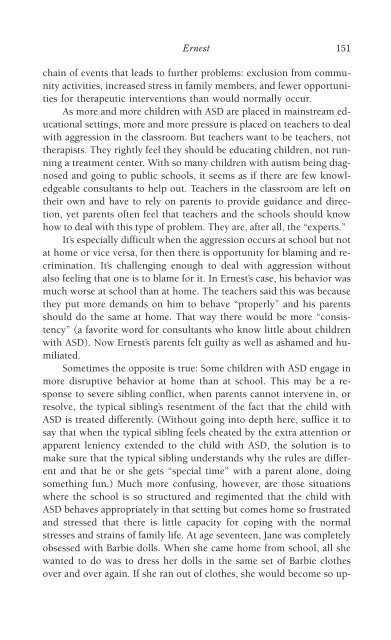978-1572305441
autism
autism
You also want an ePaper? Increase the reach of your titles
YUMPU automatically turns print PDFs into web optimized ePapers that Google loves.
Ernest 151<br />
chain of events that leads to further problems: exclusion from community<br />
activities, increased stress in family members, and fewer opportunities<br />
for therapeutic interventions than would normally occur.<br />
As more and more children with ASD are placed in mainstream educational<br />
settings, more and more pressure is placed on teachers to deal<br />
with aggression in the classroom. But teachers want to be teachers, not<br />
therapists. They rightly feel they should be educating children, not running<br />
a treatment center. With so many children with autism being diagnosed<br />
and going to public schools, it seems as if there are few knowledgeable<br />
consultants to help out. Teachers in the classroom are left on<br />
their own and have to rely on parents to provide guidance and direction,<br />
yet parents often feel that teachers and the schools should know<br />
how to deal with this type of problem. They are, after all, the “experts.”<br />
It’s especially difficult when the aggression occurs at school but not<br />
at home or vice versa, for then there is opportunity for blaming and recrimination.<br />
It’s challenging enough to deal with aggression without<br />
also feeling that one is to blame for it. In Ernest’s case, his behavior was<br />
much worse at school than at home. The teachers said this was because<br />
they put more demands on him to behave “properly” and his parents<br />
should do the same at home. That way there would be more “consistency”<br />
(a favorite word for consultants who know little about children<br />
with ASD). Now Ernest’s parents felt guilty as well as ashamed and humiliated.<br />
Sometimes the opposite is true: Some children with ASD engage in<br />
more disruptive behavior at home than at school. This may be a response<br />
to severe sibling conflict, when parents cannot intervene in, or<br />
resolve, the typical sibling’s resentment of the fact that the child with<br />
ASD is treated differently. (Without going into depth here, suffice it to<br />
say that when the typical sibling feels cheated by the extra attention or<br />
apparent leniency extended to the child with ASD, the solution is to<br />
make sure that the typical sibling understands why the rules are different<br />
and that he or she gets “special time” with a parent alone, doing<br />
something fun.) Much more confusing, however, are those situations<br />
where the school is so structured and regimented that the child with<br />
ASD behaves appropriately in that setting but comes home so frustrated<br />
and stressed that there is little capacity for coping with the normal<br />
stresses and strains of family life. At age seventeen, Jane was completely<br />
obsessed with Barbie dolls. When she came home from school, all she<br />
wanted to do was to dress her dolls in the same set of Barbie clothes<br />
over and over again. If she ran out of clothes, she would become so up-



